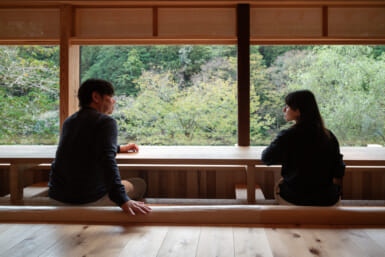Christmas is upon us and here is a tale of a good man.
His name is Kikuo Morimoto, and he is Japanese, as the name suggests. He was born on 3 November 1948 — that makes him 56 today — and left school at 17. Raised in Kyoto, he knows a bit about dyeing, and about textiles and about the techniques that go into the yuzen process to dye yarn for dreamy silks for kimono.
He chose not to exercise his trade — probably because his family needed cash, and he put two and two together… In due course, prospering as he went, he found himself in Thailand, visiting a museum. This was in 1980. Someone showed him a sample of old Cambodian silk cloth. He examined it. The craftsmanship and the quality threw him into a tizzy. Here was work of an extraordinary order. He decided to learn more about Cambodia and a silk tradition that he suddenly realized must have been — before the tragic events of the 1970s — a world leader in its field, even superior to his native Kyoto.
To make a long story short, he gave up his job in Thailand and devoted himself to work in Cambodia, a war-torn nation. In part, he says, he was motivated by a desire to alleviate poverty in Cambodia.
“People were starving and I wanted to do something about it,” he said. But there was more to it than that. He wanted to restore something very beautiful that might be lost forever. Today, he heads an organization he founded, the Institute for Khmer Traditional Textiles (IKTT). It is small and based in Siem Reap, near the famous temples of the period when the Khmer empire ruled all of Cambodia and beyond — up to the 14th century.
Mr. Morimoto calls his project “Wisdom from the Forest.” His point was this: you can’t make silk in the Khmer tradition, if you don’t have the trees. There are the mulberry trees, whose leaves nourish the precious silkworms, which spin silk cocoons around themselves. There is another tree — the Annato tree — whose seeds furnish the superb and sumptuous red that one sees in old Cambodian silks and at the workshops set up by Mr. Morimoto in Siem Reap.
There he employs hundreds of young women. To get them started — because no one remembered how to make silks any more or not of the required quality — he scoured Cambodia, high and low, travelling himself, to find women in their 50s and 60s who remembered the elements of the craft they had come to neglect.
Finding those “silk grandmas” was the key!
So yes, making things is lovely, if you have the gifts that Mr. Morimoto has for his trade. However, he had to pay for materials, and pay wages and he had to build or rent premises. To do this, the man from Kyoto set up distribution outlets far away from Cambodia. There are, for example, two such outlets in the Smithsonian Institute in Washington DC. These are within the Freer and Arthur M. Sackler galleries — they are Asian museums inside the Smithsonian.
And the forest? Well, some 23 kilometers north of Siem Reap, Mr. Morimoto is developing a plot of land in a place called Chot Sam. He has five hectares of land and several hundred workers. With them, he has built up a forestry reserve where he is growing guava trees — these are hospitable to insects known as lac. This is a very special kind of insect. If it finds one of these delectable trees, it will build nests in them and those nests are precious. They are used to make a fabulous red ochre dye. The workers pound up the nests and there is that amazing red.
Unfortunately, the wars of the 1970s laid waste to the guava trees and the lac that lived in them. The insects were all but extinct. Everything had to be restarted, with a forest conservation program that Mr. Morimoto has just commenced.
I have seen photos of him, taken in Cambodia. His face has turned a dark black in the sun. He looks to me like a monk, more like a Kyoto bonze than a businessman.
“I plan to spend the rest of my life in Cambodia,” he says.
All that I know about him, I might add, came to me through Chris McDonald, the head of Rolex in Japan. His company chose Mr. Morimoto — the first Japanese winner of a Rolex Award for Enterprise — from a pool of 1,700 applicants in 2004. Patrick Heiniger, the CEO of Rolex SA in Switzerland, chaired the selection committee.









